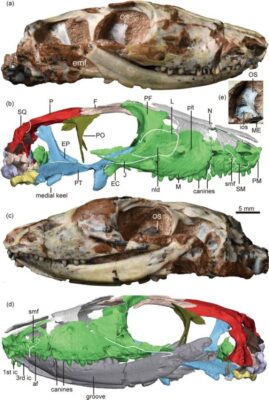A new baurioid therocephalian, Jiucaiyuangnathus confusus, was recently described from the Lower Triassic Jiucaiyuan Formation of Jimusar, Xinjiang, China. Here, two or three newly collected specimens from the same horizon of Turpan, Xinjiang, including a complete skull with lower jaw and partial skeletons, are referred to this species. The new skull is slightly larger than that of the holotype. Histological features, in conjunction with other anatomical characters, indicate known specimens should be early juveniles with an overall rapid osteogenesis and probably less than 1 year old at death. Different from the holotype, the new specimen has six upper incisors, a short diastema between the last incisor and first maxillary tooth, more distinct canines (and canine boss), and 15 dentary teeth. The new finding indicates that reduced size and/or absence of canine in the juvenile would not be a useful phylogenetic character for therocephalian. The prootics of the new specimen show unreported features from other therocephalians: a prominent medial process (may be present in Olivierosuchus) and strongly folded dorsal margin of the lateral surface. After the description of the new material, the following diagnostic features are proposed for the taxon: maxillary palatal process contacts the premaxillary vomerine process and the vomer; five to six upper incisors. Jiucaiyuangnathus confusus is the best known Baurioidea from Pangea North, and although resembling several features to Ericiolacerta parva of Pangea South, it seems quite likely that most of the similarities are related to both taxa being represented by specimens of early ontogenetic age.
Liu, J. and Abdala, F. 2025. Additional material of Jiucaiyuangnathus confusus (Therocephalia) from the Lower Triassic Jiucaiyuan Formation, Xinjiang, China. The Anatomical Record n/a (n/a).
| Néstor Fernando Abdala Investigador Principal CONICET Paleontología | |

